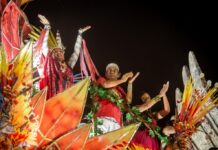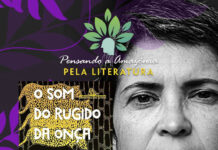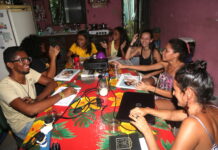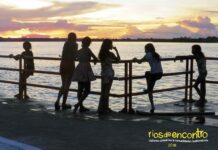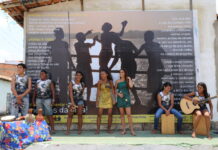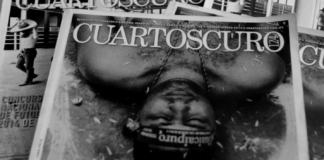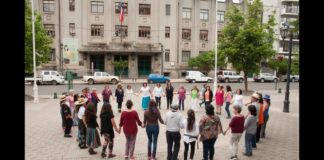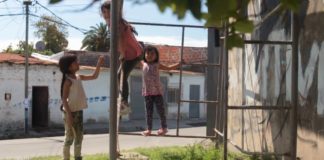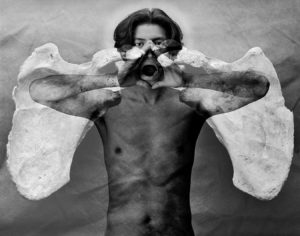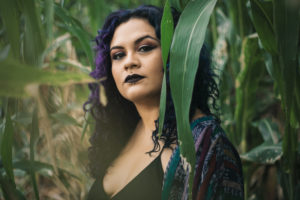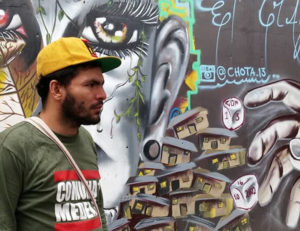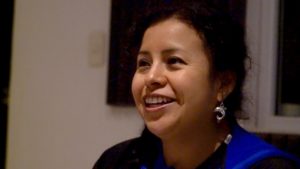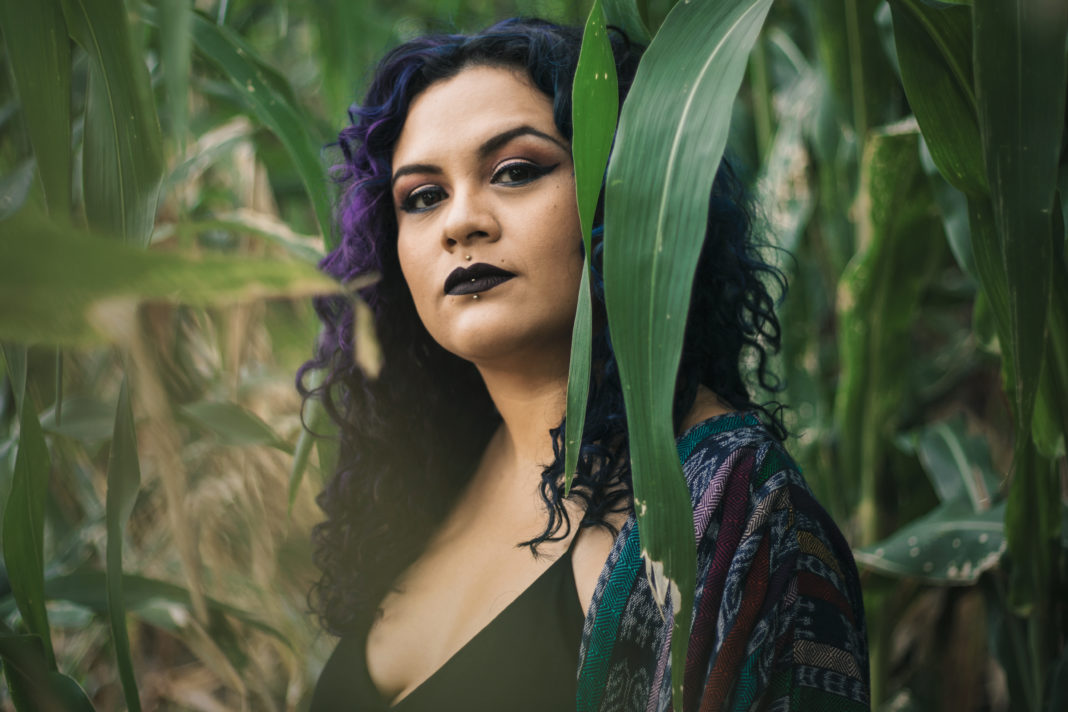
VOLA 11-1
Rebeca Lane, Guatemala. © Rebeca Lane
VOLA 11-2
Manuel Carrasquilla, Colombia. © Louise Morris 2017
VOLA 11-3
Danzante del Pochó, Tabasco, Mexico.© Dexpierte Coletivo 2018
“So That All Shall Know”
So that everyone can know/Para que todos lo sepan. Shouting Angel, Guatemala. © Daniel Hernández-Salazar 1998 / www.danielhernandezsalazar.com
VOLA 11-6
Mujeres Ajchowen perform their play Ximonïk, Guatemala. © Heidy Cabrera
11. Cultural resistance
Abstract
Art is flourishing in Latin America and has increasingly engaged with struggles for equality, group identity, justice, and memory. Music, graffiti, and memorial art provide alternative means of expression to those mandated by mainstream media, rescuing the past and helping people to construct identities for the future.
Culture also provides a space for thought and discussion of some of the most contentious social issues.
Index
News about this chapter
Ailton Krenak: Samba to portray our vision
Brazilian Indigenous leader Ailton Krenak is made a member of the Brazilian Academy of Letters. Meanwhile Samba schools at Carnival gave voice to Indigenous and Black peoples
The Amazon: the Sound of the Jaguar’s Roar
The story of Miranha and Juri, two indigenous children kidnapped from their people by German scientists 200 years ago, told in novel form by award-winning Brazilian author Micheliny Berunschk
The Amazon: rivers of life, circles of learning 3
In the last of three articles, Dan Baron continues his reliving of the Backyard Drums as it evolves into the AfroRaiz Collective, coordinators of the Rios de Encontro community arts education project based in Cabelo Seco, the 'poor' founding village of Marabá, Pará, in the Brazilian Brazil. Tensions flare among the young people, as they ‘learn to listen: to learn, rather than to gossip and slash the wings of those who want to fly.’
The Amazon: rivers of life, circles of learning 1
First of a three-part series in which Dan Baron traces the evolution of the poor children from Cabelo Seco, Marabá, Pará, into a collective of recognized Amazonian artists and leaders of their community.
The Amazon: rivers of life, circles of learning 2
In the second of three articles, Dan Baron continues his review of the eco-cultural project he has been coordinating in the Brazilian Amazon with young people from Marabá, Pará, in the Brazilian Amazon since 2009.
He revisits the history of the Backyard Drums group as it becomes the collective pulse of the the over-arching Rios de Encontro project.
Videos
Seven Heavens: the live cult of Queen María Lionza
A short video by OjosIlegales, Venezuela, shows the cult of Queen María Lionza, growing in popularity in Venezuela, which unified indigenous, black African and white European peoples in defence of nature, love, peace and harmony
The Power of Hip Hop in Protest
Louise Morris spoke with Costa Rican hip hop artist, Nakury, about the power of hip hop in protests, somatic solidarity, empowerment through hip hop culture, and how we can effectively harness music in social movements.
Chile: La caravana de las Danzas
The 2018 Caravana de las Danzas 2018, dancing in La Plaza de Talca and taking a walk around the Barrio en Colores, an open...
Towards a Living Amazon: Rios de Encontro European tour
Rios de Encontro presents the origins and eco-cultural vision of the AfroRaiz Collective of young afro-indigenous performance-educators from...
Pintó La Isla
Pintó la isla is a project of urban art developed in Isla Maciel, Avellanada, Buenos Aires. The aim is to integrate the neighbourhood into...
Louise Morris is a journalist, audio and TV producer. She specializes in women’s rights and the intersection between art and politics. Louise works producing for NPR.
She previously worked producing a daily TV magazine programme. She has written for The Wire, Delayed Gratification and BBC News Online, among others.
Interviewees
Iván Brasil (Los del Puente): interviewed in Villa Isla Maciel, Province of Buenos Aires, Argentina, on 27 May 2017 by Louise Morris. Translated by Louise Morris.
Manuel Carrasquilla, aka El Zorro (Casa Kolacho): interviewed in Medellín on 15 June 2017 by Louise Morris. Translated by Louise Morris.
Ana, Mauricio and Diego (Dexpierte street art collective): interviewed in Bogotá on 8 June 2017 by Louise Morris. Translated by Matthew Kingston.
DJLu (graffiti artist): interviewed in Bogotá on 10 June 2017 by Louise Morris. Translated by Louise Morris.
Daniel Hernández-Salazar (photographer): interviewed in Guatemala City on 25 June 2017 by Louise Morris. Translated by Louise Morris.
Juan Gabriel Gómez Alborello (Universidad Nacional de Colombia): interviewed in Bogotá on 12 June 2017 by Louise Morris. Translated by Louise Morris.
Stephanie Janaina (dancer and choreographer): interviewed in Mexico City on 5 July 2017 by Louise Morris. Translated by Louise Morris.
Rebeca Lane (hip hop artist): interviewed via email on 19 May 2014 and 4 June 2018 by Louise Morris. Translated by Louise Morris.
Totó la Momposina (singer): interviewed in Norwich, UK, on 19 May 2017 by Louise Morris. Translated by Louise Morris.
Brian Sánchez (Pintó La Isla): interviewed in Villa Isla Maciel, Province of Buenos Aires, Argentina, on 27 May 2017 by Louise Morris. Translated by Louise Morris.
Urián Sarmiento (Sonidos Enraizados): interviewed in Bogotá on 9 June 2017 by Louise Morris. Translated by Louise Morris.
Clara Alicia Sen Sipac (Mujeres Ajchowen): interviewed in Sololá, Guatemala, on 26 June 2017 by Louise Morris. Translated by Louise Morris.
References
Bigda, L. (2015) ‘A military-backed comedian will be Guatemala’s next president. Activists aren’t laughing’, The Nation, 2 November
CEH (1999) ‘Guatemala: memory of silence’, Report of the Commission for Historical Clarification, Conclusions and Recommendations, (CEH), English summary
Cepeda, E. (2018) ‘Tu Pum Pum: as reggaeton goes pop, never forget the genre’s Black roots’, Remezcla
Delgado, M. (2013) ‘The museum is in the streets: the Itinerant Museum of Art for Memory’, Globality-gmu.net
Martínez, M. (2013) ‘Peru’s painful mirror’, ICTJ.org
Sanchez, F. (2017) ‘Amid tear gas, Venezuela violinist symbolizes hope for peace’, AP News, 5 June
Villegas, R. (2018) ‘This video from Costa Rican rapper Macha Kiddo is a powerful indictment of transphobia’, Remezcla
Further reading
General
– Hierro, L. (2016) ‘Casa Kolacho: La violencia se cura con hip hop’, El País (in Spanish)
– Morris, L. (2017) ‘‘A way of healing’: Art and memory in Latin America’, BBC News
Visual art
– Basciano, O. (2018) ‘Cuban artists fear crackdown after Tania Bruguera arrest’, The Guardian
– Bellucci, J. (2016) ‘Llena de arte y color la Isla Maciel para “romper estigmas”’, Clarín (in Spanish)
– DJLU (n.d.) DJLU (profile), Street Art & Graffiti
– Gonzalez, D. (2012) ‘Angels Watch Over Memories of War’, The New York Times
– Gonzalez, D. (2013) ‘A Quest for Justice in Guatemala’, The New York Times
– Higgins, C. (2018) ‘Detained, grilled, denounced: Tania Bruguera on life in Cuba – and her Turbine Hall show’, The Guardian
– Kellaway, V. (2011) ‘Banksy of Bogotá: Colombian Graffiti Artist DJLu’, Banana Skin Flip Flops
– Morrison, C. (2017) ‘Graffiti vs the ‘Beautiful City’: Urban Policy and Artistic Resistance in São Paulo’, LSE Latin America and Caribbean Centre
– Vargas, S. (2015) ‘Seizing public space’, Development and Cooperation
Music
– Garsd, J. (2015) ‘Cumbia: The Musical Backbone of Latin America’, alt.Latino
– Guy, J. (2016) ‘Life as a Female Rapper in Guatemala, One of the Most Dangerous Places on Earth to be a Woman’, Noisey
– Haberman, C. (2018) ‘He Died Giving a Voice to Chile’s Poor. A Quest for Justice Took Decades.’, The New York Times
– Jessel, E. (2017) ‘Chocolate Remix: the lesbian reggaeton artist taking on the ‘supermachos’’, The Guardian
– Nelson, S. (2018) ‘Using Music to Fight for Women’s Rights, Meet Guatemalan Rapper Rebeca Lane’, Culture Trip
– Salpicón, S. (2017) ‘‘No voy a censurarme para no incomodarles’: Rebeca Lane is breaking boundaries with hip-hop’, Sounds and Colours
– Slater, R. (2018) ‘An introduction to cumbia in 20 essential records’, The Vinyl Factory
Theatre and performance art
– Breukel, C. and Cader-Frech, M. (2016) ‘Performing El Salvador – Contemporary Art: A Social and Political Gauge’, ReVista

